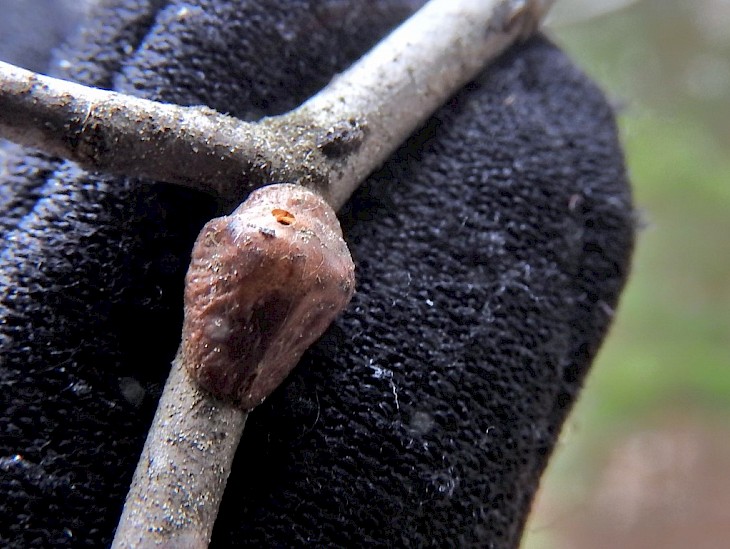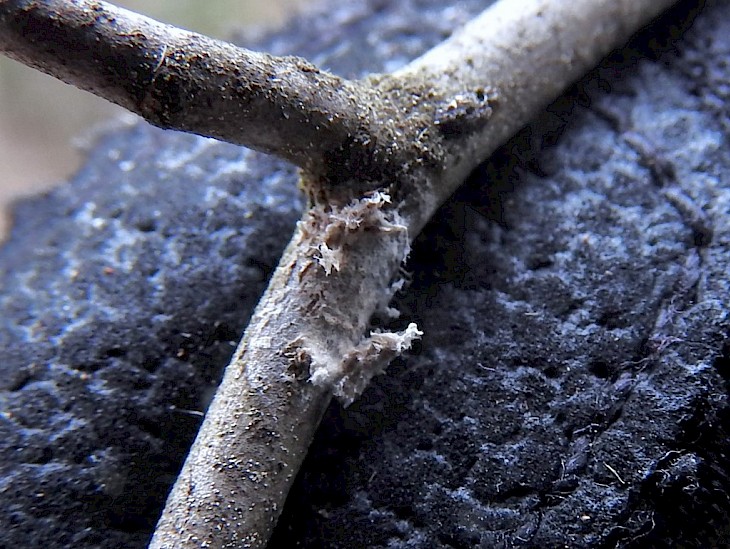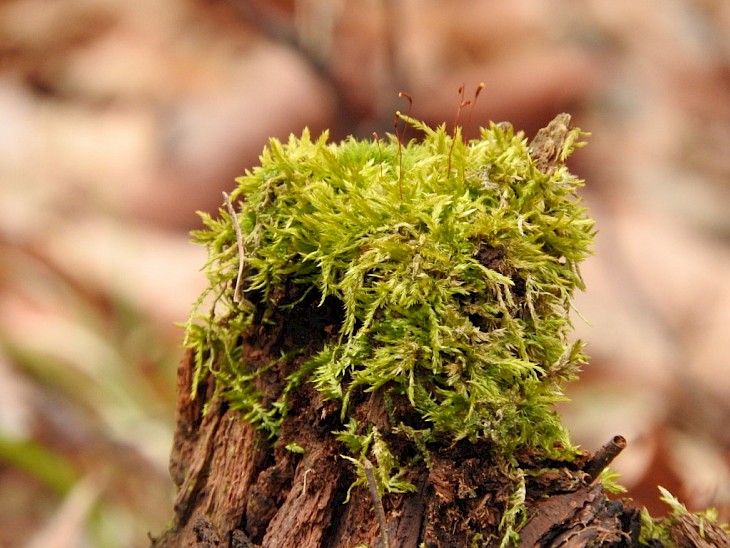(This is the most elegant scat I’ve ever seen)
I’m not sure why the small, brown bump on the twig caught my eye. I think I was reaching down to pick up my backpack after having extricated myself from the bushes where I was attempting to get a photo of a cute mossy stump. This hike on the North Country Trail had started to feel a little like whiplash. I was motivated to hike fast in the cold, damp weather, but neat things kept catching my eye.
First it was the most elegant scat I’ve ever seen. Pure-white fur cascaded down a mossy stump, its arrangement clearly indicating its origin. Any mucky parts had washed away in the thaw. I wished well to the spirit of the snowshoe hare, and to the belly of whichever weasel that ate it.
Next I spotted a tiny mound of dirt and dried leaves, pushed up in the middle of the path. The earthworms must have been active during a thaw! I shook my head at this invasive species, and gazed forlornly at the forest. A carpet of dingy green Pennsylvania sedge with few indications of tree saplings, and little hope for spring flowers, stretched out under the deciduous canopy. Here was a classic example of a worm-eaten forest.
Mushrooms, woodpecker holes, evergreen wood ferns, leaf molds, and cracked ice also called to my camera before the lens settled on that last moss-covered stump. And then, those small, brown bumps on the twig. How did I ever spot those?

(Scale insects create a waxy shell to help protect their soft bodies, but the small hole on the upper left corner of the shell indicates that a parasitic wasp broke through the defense)
The size, coppery color, and slight sheen of the bumps closely resembled the ironwood tree’s own buds, but the bumps were scattered along the twig. One brushed off in my gloved hand, and I discovered white fuzz inside the little hollow dome. Its former place on the twig was marked by a faint spot of white residue. After snapping a few photos, I moved on. But the mystery bumps kept ‘bugging” me. Who made them?
A friend suggested scale insects, and that had been in my mind, too, although I realized I couldn’t even tell you exactly what a scale insect is. As it turns out, their life story is pretty fascinating, and—typical of insects—a little weird.
The little brown domes I found affixed to the twigs may have belonged to sub-adult females, but from the looks of them, females that didn’t survive. On one shell I noticed a pencil-point hole: the telltale sign of a parasitic wasp escaping after doing its (very important) dirty work. Another possibility is that these scales had simply matured and reached the end of their natural lives.
What are their natural lives? When successful, female nymphs overwinter on twigs. In the spring, if all goes well, they will finish maturing and then lay eggs (sometimes more than 1000 of them!) with or without the help of a flying male. The eggs are laid underneath the protection of their mother’s stationary shell, and the female herself then dies and dries. The eggs hatch about ten days later, and small, yellowish “crawler” larvae migrate to leaves. At this stage, the crawlers might be blown by the wind or even transported on the feet of birds to new locations.

(When the scale flaked off, a white reside was left. It might have been left from the eggs, or part of the mother’s body)
Like their relatives the aphids, the scale larvae insert sucking mouthparts (called stylets) into the plant and start drinking. In order to get enough nitrogen, they must drink an excessive amount of the sugar-rich sap, which they excrete as “honeydew.” Ants take advantage of this just like they do with aphids, and can often be seen drinking honeydew off the scale insects.
As the nitrogen and sugar fuel their growth, the scale larvae molt. With each molt, their bodies become larger and their legs become smaller. Finally, in late summer before their legs completely disappear, the nymphs walk back down the leaf stalk and onto their winter home on the twig. They build their waxy, protective shells, and do not move again. Spring brings maturity, reproduction, and death.
Males do occur, but their larvae and nymphs are flat and nearly transparent. Adult males are tiny, winged, and have no eating mouthparts.

(This cute little stump caught my eye, and also led me to discover another mystery!)
I can’t even begin to tell you what species of scale insect these might have been. After starting my research, I wished that I’d looked under more scales and brought some home, too. Apparently, the variation in appearance within a species of scale is sometimes greater than the variation between different species. Some species only feed on one or two host plants, but many other species are generalists. There are both “armored” scales and “soft” scales with slightly different life histories. Occasionally, outbreaks of scale insects can damage trees, but they are not always a problem.
Whether it’s hairy scat on a mossy stump, worm castings in a lawn-like forest, or tiny brown bumps on a twig, every bit of the world tells its very own story if we’re able to listen.
Special Note: Emily's book, Natural Connections: Exploring Northwoods Nature through Science and Your Senses is here! Order your copy at http://cablemuseum.org/natural-connections-book/. Listen to the podcast at www.cablemusum.org!
For 50 years, the Cable Natural History Museum has served to connect you to the Northwoods. Come visit us in Cable, WI! Our new exhibit: "Better Together--Celebrating a Natural Community" will open on May 3!
[Photos by Emily Stone]
Last Update: Mar 29, 2017 9:57 am CDT

















